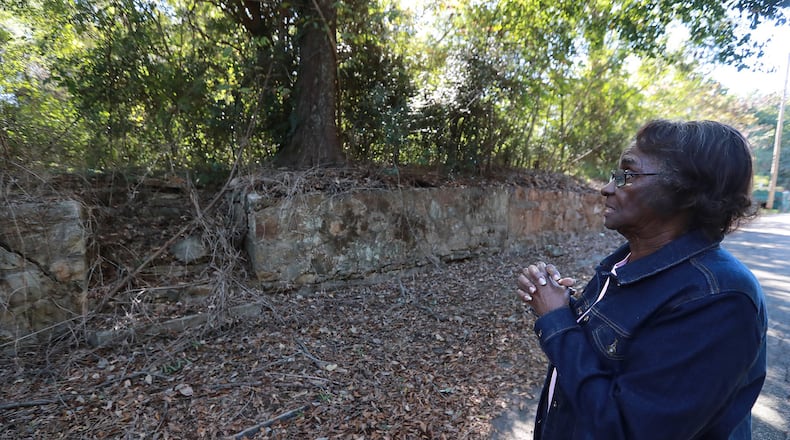Now, it’s empty.
The shop closed in September, after the city purchased the land with plans to build a massive mixed-use development on 375 acres that included Price’s property.
Price, 82, said people had still been coming to his corner for their cuts and shaves. But the area around him had long ago been largely abandoned. Atlanta and the federal government bought residents out of their homes beginning in the 1970s, as Hartsfield-Jackson International Airport’s expansion ate up existing communities. When the people left, churches and stores followed.
From 1980 to 2018, Census estimates show that College Park — population 15,212 — lost 38% of its residents.
City leaders hope this new development will get many of them back.
This summer, the government approved a master plan for a project it’s calling Airport City, an ambitious $1.5 billion undertaking that would boost College Park’s population once again and — city leaders hope — attract new businesses and travelers to make College Park a destination.
“This is our opportunity to show the world, and the rest of Atlanta also, that College Park is a good place to live,” said Artie Jones, College Park’s economic development director.
Jones and others hope the project will lure more wealth to the city, including the possibility of a corporate headquarters and the high-paying jobs that come with it.
In College Park, which sits at the airport’s gateway, only a quarter of residents own their own homes and the median income is $29,087. That’s far below the rest of Fulton County, where half of residents own the homes they live in and the median household income is $61,336. In all of metropolitan Atlanta, 63 percent of residents own their homes and the median household income is $61,733.
The master plan calls for repopulation of some of the area that was largely abandoned over several decades because of noise from the airport. There are still restrictions on where homes can be built on the site, so College Park plans to build housing outside the flight path, on 52 acres on the outskirts of the property. A second phase of development would take two holes of the city-owned golf course for housing.
Additionally, there are height restrictions that will dictate the layout of the rest of the mixed-use project.
Initial plans include mom-and-pop stores toward the front of the land, shopping and office space, a hotel and entertainment options, like an experimental golf venue and a venue for E-sports competitions. A recreation center is already being renovated and an amphitheatre and other amenities could also be in the offing. All told, the development could cost $800 million for its first phase, over five years. The city plans to break ground early next year, and will start by realigning some roads.
‘This is the saddest thing’
It’s bittersweet for people like Price, who said he knows the improvements will be good for the city, but who wasn’t quite ready to let go of his barbershop.
“I just hope I’ll be here long enough to see it develop,” Price said. “Time is running out, I know.”
One afternoon in October, Price drove through the overgrown streets with other old-timers who marveled at the ruins of the neighborhood and dreamed about what it might become. Some roads were closed, blocked by fallen trees; others were little-traveled, the homes on them having been torn down years ago.
Wilma Abbott Nichols, 80, moved into a West Columbia Avenue house built by her grandparents when she was 5 or 6 years old; she moved out when she got married, at 19. Driving around, she recognized the crumbling steps that would have led up to her childhood home.
"This is the saddest thing," she said, standing in the driveway. "I'm always really sad to see what happened. It was a really tight community. I knew my neighbors. I think about mother and daddy. I still miss them, after all these years."
Bussey’s grocery store, Laster Chapel United Methodist Church, Mount Zion: They’re among the community gathering places that closed or scattered. Charles Dowdell, 79, said it was as if “College Park basically went to sleep” 40 years after the buyouts.
Dowdell lives in East Point now, and he thinks the Airport City project will “get the new generation” if it succeeds. But he isn’t sure it will.
“I’d like to see it, but I don’t have a whole lot of confidence in it,” he said.
Jones, with the city, said there are some challenges. The project “did not get a warm reception” at an International Council of Shopping Centers conference in Las Vegas in May, he said, and some of the restrictions will make building a challenge.
But, Jones said, the land is “a very, very nice piece of property,” and it has a story to go with it. If it succeeds, Jones said, Airport City “will definitely have an effect on homeowners all over College Park.”
‘A little nutty’
Steve Berman, founder of OA Development, said he has some doubts about the plan — but he’s confident College Park will get it right.
“Any real estate project has got to have some dreams and aspirations that are a little nutty,” Berman said. “It’s absolutely not impossible.”
Berman said College Park’s mayor, Jack Longino, has “an incredible record of success.” The city just opened a new arena, Gateway Center at College Park, and Longino is in a runoff to remain mayor of the 10-square-mile city.
But, Berman said, he’s had some trouble leasing an office building he has in the city, and warned city leaders to be cautious. The success of the residential component, he said, will make or break the project.
If it succeeds, he said, “it has a chance to be transformational.”
"These airports serve as massive hubs of commerce and economic activity," Berman said. "We're sitting on the proverbial gold mine."
That’s what Jones and others hope. But the process to begin the project is still in the works — the Atlanta Regional Commission has yet to weigh in on the plan — and there are no guarantees when it comes to development.
When everyone moved away, Emma Schell Dudley, 88, said the relationships she and others had were frayed. Driving around, she was eager to hear about the project. The street names will be the same, and the homes are returning, but the gleaming renderings don’t leave room for the working-class people who lived there before. The new residences, Jones said, won’t be affordable housing.
“In other words, we still can’t come back,” Dudley said.
About the Author
The Latest
Featured




